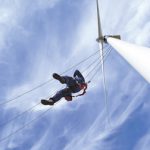The Ironworker Progressive Action Cooperative Trust (IMPACT) is a non-profit, labor-management organization devoted to improving the ironworking industry. One of the ways that the IMPACT trustees deliver on this mission is by always looking for new and innovative ways of making ironworkers and the contractors they work for more competitive. There is no better method of doing this than through workforce training.
Ironworkers and the contractors they work for have been erecting wind turbines for many years. To meet the needs of the industry, the International Association of Bridge, Structural, Ornamental and Reinforcing Iron Workers has always maintained a wind turbine training strategy, ensuring that ironworkers had the needed knowledge and skills to safely and efficiently erect wind turbines. That strategy, still in place, includes the following training components:
• Information on wind turbine erection in the “Structural Steel Erection” training package;
• Information in the “Structural Steel Erection” training package focusing on bolt torqueing and tensioning (although not focusing specifically on wind turbines);
• “Rigging for Ironworkers” training package to teach heavy rigging procedures;
• “Cranes” training package to teach to the use of cranes (including signaling).
This training strategy has provided ironworkers with not only wind turbine erection market share, but also the necessary knowledge and skills to safely and efficiently erect wind turbines for decades.
In 2008 and 2009 there were a lot of wind turbines being erected in the United States. Most projections were that the upward trend of the construction of wind farms would continue, and most likely increase, into the foreseeable future. Because of this increased amount of work, and the anticipated further increase, according to input from many of IMPACT’s signatory contractors there was a growing need for ironworkers to have third party, nationally recognized training certifications in several areas. These areas include wind turbine tower climbing and rescue, as well as bolt torque and tension training.
In June of 2009 two things happened that shaped wind turbine training for ironworkers. First a team traveled to Oklahoma to evaluate a wind turbine training program, and second the Department of Labor (DOL) released several grant solicitations as part of the American Reinvestment and Recovery Act of 2009 (ARRA). A team representing the Ironworkers International—referred to as “Ironworkers” from this point forward—IMPACT, and several local unions visited the Wind Turbine Technician Training program at the Francis Tuttle Technology Center (FTTC) in Oklahoma City. Team members included: Tad Kicielinski, general vice president; Mike Gravette, Texas and Mid-South States District Council; Ron Smitherman, business manager for Local 263 in Dallas; Randy Palumbo, apprenticeship coordinator from Local 48 in Oklahoma City; Rick Sullivan, IMPACT director of education and training; and myself.
FTTC is a non-profit, accredited technology training center in the state of Oklahoma and a member of the American Wind Energy Association’s (AWEA) education committee, as well as a member of the Wind Energy Training Consortium (WETC). The WETC is a group of training institutions that is recognized by AWEA as promoting the skill training essential for wind turbine technicians.
The wind turbine technician training program in place at FTTC was found by the team to address all three areas of interest to the Ironworkers, with a very strong hands-on focus. The FTTC program had industry partnerships with HYTORC, Snap-on Industrial, and Capital Safety (DBI/SALA) so that program completers receive certificates from these three nationally recognized organizations. FTTC was also willing to partner with IMPACT and train ironworkers on demand. Figure 1
The Ironworkers team made a recommendation to the IMPACT trustees that a partnership be developed with FTTC in order to rapidly meet the demands of this growing sector of the ironworking industry. The trustees then formed a training partnership with FTTC to train ironworkers and deliver only the segments of the wind turbine technician course that were pertinent to the erection and heavy maintenance of wind turbines. These courses are comprised of training in two major areas of the wind turbine industry: tower climbing and rescue, as well as bolt torque and tension.
The tower climbing and rescue training portion of the course covers the different forms of fall protection, rescue and evacuation techniques, types of equipment, and the proper use, care, and maintenance of the type of safety and rescue equipment used in the wind energy workplace. Upon successful completion of this component of the course participants receive a nationally recognized certification from Capital Safety.
The bolt torque and tension certification component of the course will certify participants in all aspects of bolt torque and tension. Topics include basic fasteners and safety, and mechanical, electronic, and hydraulic torque. This portion of the course uses a tremendous amount of hands-on learning, application, and three certifications from industry leaders Snap-on Industrial and HYTORC.
The goal of these courses is to rapidly train ironworkers to get them onto wind turbine erection sites; it is not a “train the trainer” course. These courses cover 36 hours of related classroom and hands-on instruction, and the course spans four days. Because the course is delivered in a highly accelerated manner, only journeymen ironworkers with a minimum of three years field experience who already have the OSHA 10, Subpart R, and First Aid/CPR/AED training will be eligible to register in one of these courses. Figure 2
IMPACT and FTTC jointly arrange for one wind turbine course to be held each calendar quarter at FTTC’s Portland campus; one of FTTC’s three campuses in the Oklahoma City metro area, this campus is the site for FTTC’s wind turbine technician training. Ironworkers are signed up for and registered for these courses through the IMPACT office at the request of either a local union or a signatory contractor. However, if a local union or a signatory contractor has anywhere between six and 10 ironworkers who need this training in order to work on a wind turbine erection or maintenance project, IMPACT will work with FTTC to arrange for a “private” course to be conducted within 45 days of the request.
Once participants complete the training and are issued the certifications—since these are third-party certificates, some may take three to four weeks to come back from the industry vendor—the IMPACT office receives an electronic copy of the certifications. The Apprenticeship and Training Department then updates the Apprentice Tracking System (ATS) to show the certifications that the ironworker received and places an electronic file of the certificate on the ATS, as well. Since the ATS is a Web-based secure system, this allows any local union to verify that an ironworker has these certifications and can meet the needs of the contractors. Figure 3
When the DOL announced large grants under the ARRA, there were several meetings at the Ironworkers International to discuss whether or not it would pursue any of the available grant money. It was decided that International, through IMPACT and the National Training Fund, would submit a grant proposal. It was understood that the competition would be tough and the amount of awardees limited, but they were confident that they could develop a competitive proposal. After reading the announcement in the Federal Register in detail, it was easy to see that a national entity was required to work with at least two but no more than five of its local affiliates in order to implement training.
The National Training Fund and IMPACT decided to write a grant that would allow the Ironworkers to take the IMPACT wind turbine partnership training (developed with FTTC and described above) and replicate it at five existing local training centers.
In order to identify these five local training centers, IMPACT looked at the projections for wind farms for the coming two years (also the term of the grant). The five regions of the country projected to have the most wind turbine erection work were identified, and the district council presidents of those regions then identified which training center in that region was best suited to be involved in the grant. The five local training centers chosen to participate in the grant were the training centers for the following Ironworkers local unions: Buffalo, New York; Salt Lake City, Utah; Dallas/Ft. Worth, Texas; Los Angeles, California; and Joliet, Illinois. Some of the other stipulations in the DOL grant solicitation required that each of the local training centers do the following:
• Work with contractors involved in wind turbine erection and to have those contractors supply a letter of support;
• Partner with the state and/or local Workforce Investment Boards (WIB) and get a letter of support;
• Establish or have a relationship with the “one-stops” in the local area.
The Ironworkers grant proposal was written during the summer and then submitted to the DOL in September of 2009. In January of 2010 the DOL announced the grant awards and the Ironworkers was one of the successful organizations. The wind turbine training will be delivered at the five local training centers by instructors who received specific instruction at the FTTC from certified industry partner trainers. The National Training Fund will then equip each of the local training centers with their industry partners’ tools and equipment so that those trainers can begin to conduct wind turbine training for Ironworkers. Each training center will also receive a mobile training trailer to be pulled either directly to wind farm sites or other local training centers to conduct this certification training. By taking the training “on the road,” not only will a wider geographical region be serviced with DOL grant funds, but more ironworkers can receive training. This will ensure that each training center will be able to provide at least 102, including the two instructors trained at FTTC, trained ironworkers with industry recognized certificates by the end of the grant, for a total of at least 510 trained and certified ironworkers under the DOL grant funded training. Figure 4
The two wind turbine training developments forged under the supervision of the IMPACT trustees and with the partnership of the Francis Tuttle Technology Center and the Department of Labor are examples of what can happen when both labor and management work together towards a common goal. These two progressive training programs are providing ironworkers with certifications that will enable employers to secure projects and put more people to work. Figure 5Figure 6








































